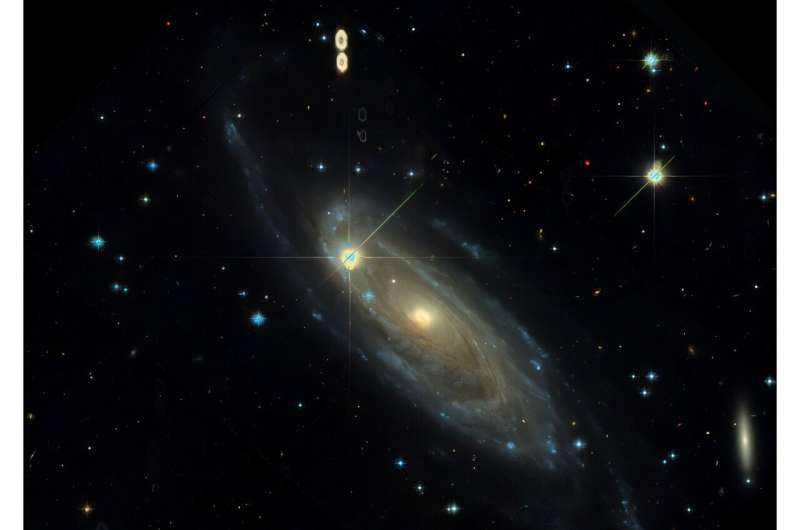Astronomers have employed the Canada-France-Hawaii Telescope (CFHT) to perform comprehensive multiwavelength observations of a large and massive spiral galaxy known as UGC 2885. Results of the observational campaign, published October 21 on the pre-print server arXiv, provide more insights into the properties of this galaxy.
Located some 232 million light years away, UGC 2885, also known as Rubin’s galaxy, is a barred spiral galaxy in the constellation Perseus. With an estimated radius of about 400,000 light years and a total mass at a level of 1.5 trillion solar masses, it is one of the largest and most massive galaxies in the local universe.
Previous observations of UGC 2885 have found that it has an undisturbed spiral structure, which is unexpected for such a large and massive object. In particular, this galaxy showcases a near-perfect structure of the spiral arms and disk, and has no tidal tails. Moreover, contrary to other massive spiral galaxies, UGC 2885 has a relatively low star-formation rate—of about 2.47 solar masses per year.
These unusual properties of UGC 2885 raise questions regarding its evolution, and a team of astronomers led by Matheus C. Carvalho of University of Western Ontario, Canada, decided to investigate it with CFHT’s SITELLE spectrograph.
“Our goal is to understand whether UGC 2885 has followed a similar evolutionary path to other high-mass galaxies by examining its place on the fundamental metallicity relation and the star-forming main sequence,” the researchers explained.
The study found that UGC 2885 has a global metallicity of around 9.0 and is uniform within 0.3 dex over a large radial extent in this galaxy. This places UGC 2885 in the high metallicity regime consistent with its large stellar mass, which was measured to be about 483 billion solar masses.
The collected data indicate that UGC 2885 has an integrated molecular hydrogen mass at a level of 189 trillion solar masses. The galaxy also has an extreme molecular-to-stellar mass ratio of about -0.41. However, mechanisms that could add cold gas to UGC 2885 still remain unknown as it is a completely isolated galaxy without any companions or a clear recent merging event.
Furthermore, it was found that UGC 2885 has a mean global star-formation rate of approximately 1.63 solar masses per year. This is a low value when compared to known super spiral galaxies.
According to the authors of the paper, the obtained results suggest that UGC 2885 went through cycles of star formation periods, which increased its stellar mass and metallicity to its current state. However, no evidence for any significant recent starburst or merging events has been found by the researchers.
More information:
Matheus C. Carvalho et al, A multiwavelength overview of the giant spiral UGC 2885, arXiv (2024). DOI: 10.48550/arxiv.2410.16467
Journal information:
arXiv
© 2024 Science X Network
Citation:
Observations explore the properties of giant spiral galaxy UGC 2885 (2024, October 29)
retrieved 29 October 2024
from https://phys.org/news/2024-10-explore-properties-giant-spiral-galaxy.html
This document is subject to copyright. Apart from any fair dealing for the purpose of private study or research, no
part may be reproduced without the written permission. The content is provided for information purposes only.

